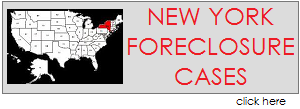Hat Tip to a viewer for this…
There are numerous complaints from conservatives, political and economic, as to the continuation of the federal GSEs and guarantee programs that dominate the market place. These matters now are coming to the forefront of Congressional consideration in the wake of passage of FINREG. The bifurcated approach was practically driven: one bite was too much to swallow, and the methods of solution are dramatically different.
FINREG has been described as a broad general outline for actions yet to be taken by as many as 16 federal agencies through rule-making processes. One of the most potentially significant pieces of this regulatory maze is supposed to be the Consumer Protection Agency tucked away in Federal Reserve. The rule-making process will be long and tortured. Agency lawyers basically offer up drafts for comment by the public. The “public” translates into “special interests”. These are generally consumer protection groups, or industry groups. Legions of industry specialized lawyer-lobbyists comment in technical terms that are incomprehensible to 99% of the lawyers in the country. The complexity tends to make it an insider ball game. Industry lawyer-lobbyists that worked the bills know where the choke points are—where the skeletons are hidden. Consumer advocates are few and far between—generally outgunned– certainly underpaid in comparison to the well-financed industry groups. Disinformation is industry’s stock in trade. Confusion is its currency. By the end of the process even the most well-meaning regulators are overwhelmed. What to believe? Who to believe? Much like the judiciary, the rule-makers receive comments from the industry side, and wait to hear the consumer rebuttals. If the rebuttals are poorly framed, the consumer comments are placed in the shadows. Even when the most aggressive rule-making process generates in a proposed rule, the rule-regulation may be held in suspense for decades. The existing agencies will be best able to engage in rule-making quickly. No doubt industry-originated drafts are already circulating in at least some instances.
For an entirely new rule-making authority, it may take a year or more simply to find the writers, employ them, then map a strategy and initiate the formal rule-making process. Years pass—other agencies with a head start fill the void. Conflicting rules are inevitable—the new agency may be consumed initially simply by attempting to stake out its jurisdiction by submitting comments to other agencies rule-making either directly in the public record or through back-room confrontations. What is the effect?
Generally, regulations emerging from a rule-making procedure are either or “interpretative” or “legislative” rules. Interpretative regulations cite to various legislative provisions to clarify already reasonably definitive statutory mandates. The interpretative rules are promulgated by the agency charged with jurisdiction over the subject matter. The responsible agency writes rules to clarify broader statutory language, or conflicting statutory language. Sometimes this type of rule-making will parrot statutory language in order to provide the agency with a statement of internal policy upon which specific case determinations may be based. These latter agency decisions may be referred to as rulings but more correctly are described in administrative law as “orders”. The agency that promulgates interpretative regulations is bound by and must follow those regulations in its individual case decisions/orders. Interpretative regulations may be applied retroactively in the reasonable discretion of the agency. The retroactive application is often challenged by industry members subject to orders based on the regulation. Generally the industry will argue that the interpretation conflicted with underlying statutory intent as reflected by committee reports, floor speeches by sponsors etc. The industry may also argue that the orders pursuant to interpretative regulations may not issue for retroactive application in event that they conflict with long-standing administrative practice by that agency, and may even go so far as to state that the longstanding practice was implicitly incorporated by statute even if not specifically referenced. The theory is that the legislature is all-knowing, and adopts administrative rules implicitly when legislating in that area because the legislature would have specifically altered the treatment if it had so intended. These fears tend to make retroactive application difficult and contentious.
A legislative body may also authorize legislative rule-making. Generally, this will be done by language such as the “agency shall write rules to implement the purposes” of the general legislative mandate. Other times, there will be a more ambiguous direction: “this section shall be effective upon adoption of regulations”. In the latter case, the agency is basically vested with authority to decide for itself if and when it needs the rules to be created and applied. Agency discretion in the context of legislative rule-making is tantamount to a punt by Congress to the agency of matters too complex for legislation. These matters are supposedly within the special expertise of the agency and its word is law virtually equivalent to Congress’. Legislative regulations are drafted by persons appointed or supervised by the then-current Administration.
The regulatory path generally follows the following course: Congress passes a statute with Committee Reports. The agency determines the priority of required or permitted action. The Agency publishes intent to engage in rule-making in a described area. Sometimes this is described as “Advance Notice of proposed Rule-Making” or ANPRM. Sometimes it is simply notice of Proposed Rule-Making. In any event, the notice generally constitutes the beginning of agency hearings and/or opening of a comment period during which the agency is accessible to introduction of information, supposedly on the record.
The agency takes comments, hears testimony and investigates facts. It makes determinations of fact and law and writes regulations accordingly. The agency will typically publish “proposed rules” incorporating and addressing the comments made during the open hearing process. The notice of associated with published proposed rules should invite further comment—but on a more limited basis. The proposed rules may stand in place for years, while under attack from all sides. Eventually—as much as 20 years later—the proposed rules tested by time may become “final”.
What does this mean to the community of mortgagors—subjects of predatory loans and predatory collection practices?
To bring it home dramatically to relate to current discussions, the decision by Bankruptcy Court Judge Federman, in B.R. Western District Missouri Case # 10-20086; In re: Box stated at page 8, “The fact that the February 18, 2010 assignment [typical MERS as nominee of a bankrupt originator] was made after the bankruptcy case was filed does not render it per se invalid in that there is no rule prohibiting a creditor from assigning its claim postpetition.” [Emphasis Added]. This has implications with respect to tracking custody, obtaining discovery, simply unraveling the transactions. It touches upon the after-acquired note issues, and generally invites frauders and their successors to carry on in good stead.
In another hot recent case, Cleveland vs Ameriquest et al, U.S.C.A. 6th Cir. No. 09-3608, the Court responded to Clevelands’ assertions of injury by underwriters that “began to direct lenders on the types of loans to meet the [underwriters’] securitization needs….and turned a blind eye even when the loans made no economic sense.” The District Court below had decided that the city had no claim that the defendants had abetted a nuisance, ”because subprime lending…is legal”. Interestingly, the facts pled suggested that the city asserted not just subprime, but predatory, subprime lending. References to official sources bear out this connection between predatory and un-economic loans. Quoting from a well-done brief on the topic;
“Specifically, in the matter of Associates Home Equity Services v. Troup, 343 N.J.Super. 254, 267 (App. Div. 2001) the Appellate Division opined:
Predatory lending as been described as: a mismatch between the needs and capacity of the borrower… In essence, the loan does not fit the borrower, either because the borrower’s underlying needs for the loan are not being met or the terms of the loan are so disadvantageous to that particular borrower that there is little likelihood that the borrower has the capacity to repay the loan. (citations omitted).
This definition set forth by the Appellate Division is entirely consistent with Federal guidance on the topic. Specifically, by “Advisory Letter” AL 2003-2 from the Office of the Comptroller of the Currency (“OCC”) to the Chief Executive Officers of All National Banks…, the OCC stated:
The terms “abusive lending” or “predatory lending” are most frequently defined by reference to a variety of lending practices. Although it is generally necessary to consider the totality of the circumstances to assess whether a loan is predatory, a fundamental characteristic of predatory lending is the aggressive marketing of credit to prospective borrowers who simply cannot afford the credit on the terms being offered. Typically, such credit is underwritten predominantly on the basis of the liquidation value of the collateral, without regard to the borrower’s ability to service and repay the loan according to its terms absent resort to that collateral. (emphasis provided).
Furthermore, Section 39 of the Federal Deposit Insurance Act generally requires Federally Chartered banks to establish “safety and soundness” standards for underwriting loans. At 12 C.F.R. Part 30—Appendix A, “Interagency Guidelines Establishing Standards for Safety and Soundness,” the various federal agencies who regulate banking institutions were directed to consider a number of factors in implementing loan underwriting guidelines.
At subpart “C.” lenders are directed to “…establish and maintain loan documentation practices that:
***
2. Identify the purpose of a loan and the source of repayment, and assess the ability of a borrower to repay the indebtedness in a timely manner.
At subpart “D” lending institutions are directed to “establish and maintain prudent credit underwriting practices that:
***
3. Provide for consideration, prior to credit commitment, of the borrower’s overall financial condition and resources, the financial responsibility of any guarantor, the nature and value of any underlying collateral, and the borrower’s character and willingness to repay as agreed.’”
So the question now is whether the City of Cleveland failed to properly assert that subprime predatory lending was the subject of the complaint—or the Court has ruled that “predatory lending” is legal?
Much if not most of the mortgage crisis arose as a result of predatory lending on steroids. The reasons were varied: 1) to generate fees all around by refinancing loans and originating new ones, 2) to obtain products to sell to investors as a steep markup—more fees/profits and last but not to be over-looked in respect of predatory loans, the servicer is entitled to hold the proceeds of foreclosure until the tranche MBS are “called” bought out and the trust is closed—or investor payout as prescribed in the MBS themselves whichever comes 1st. the main driver for “designed to fail” or predatory loans was the probability that the loans would default and the originator’s servicing rights’ foreclosure pool would grow as the foreclosures went on according to plan.
Now clearly the above 2 issues among many are critical to the continuation or termination of the practices which have crushed the entire home-owning population of America, along with the economy, the future of our children, and destroyed the prospect of comfortable retirements for even the most diligent workers. The length and breadth of the damages from this obscene—but not illegal?—behavior is without parallel.
The last hope for correction in the future if not the past is the orderly and honest establishment of a keen regulatory system that directly addresses these and related issues. This will occur in Agency hearing rooms, in Comments and testimony before the agency staffs. A coordinated effort by advocates is necessary to identify cases of abuse, why they happened and what would prevent the same thing occurring again.
If I have misstated, understated or need to identify further stark examples of judicial distress due to confusion of the law, please post your suggestions. We need to identify corrections before the industry glosses over them. Do not play defense—play offense.
© 2010-19 FORECLOSURE FRAUD | by DinSFLA. All rights reserved.



















Recent Comments